A Walk In London
If you're British, you not only know about but probably own at least one A-Z
map, published by Geographers' A-Z Map Company Limited, perhaps of London, perhaps of your own town, and I daresay you take it for
granted. Having come upon the London A-Z late in life (about ten years ago), and
found that I like nothing better in an idle moment than exploring its pages, I
haven't been able to decide whether the British just make better maps than
anybody else or instead simply inhabit a more interesting geography. It's
obvious that London's layout has never been rationalized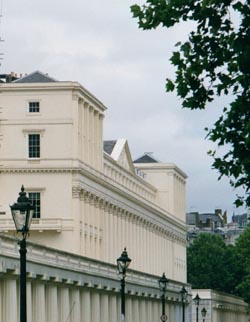 (despite occasional
attempts); no Baron Haussmann was ever commissioned to plow boulevards through
the City's labyrinth, and one might almost infer a local antipathy to right
angles. The Prince Regent, I read somewhere, had a dream of connecting his
palace on the Mall, Carlton House (since replaced by a stupendous Beaux-Arts
terrace), with Marylebone Park, which he renamed after himself in 1811. A look
at the map, however, shows that triumphal aspirations yielded to vested
interest. The bottom of Regent Street curves toward the East and away from St
James, whose denizens would probably not have allowed the condemnation of their
properties on terms favorable to the Crown. So what was originally planned as an
Enlightenment thoroughfare ends instead in an idiosyncratic, if graceful, arc.
Long straight lines are refreshingly uncommon in London. Getting lost is
easy. One's destination is a treasure that can't be found without the help of a
map.
(despite occasional
attempts); no Baron Haussmann was ever commissioned to plow boulevards through
the City's labyrinth, and one might almost infer a local antipathy to right
angles. The Prince Regent, I read somewhere, had a dream of connecting his
palace on the Mall, Carlton House (since replaced by a stupendous Beaux-Arts
terrace), with Marylebone Park, which he renamed after himself in 1811. A look
at the map, however, shows that triumphal aspirations yielded to vested
interest. The bottom of Regent Street curves toward the East and away from St
James, whose denizens would probably not have allowed the condemnation of their
properties on terms favorable to the Crown. So what was originally planned as an
Enlightenment thoroughfare ends instead in an idiosyncratic, if graceful, arc.
Long straight lines are refreshingly uncommon in London. Getting lost is
easy. One's destination is a treasure that can't be found without the help of a
map.
Most of Manhattan is the very opposite of London. Memorizing the order of the avenues, their intersections with Broadway, and the four corners of Central Park poses the lightest of burdens, and the streets run from 1 through 150 and beyond without a break. The only reason for consulting a map is to locate street addresses by number: what's the nearest cross street, say, to 350 Fifth Avenue? Deviations from the grid are so uncommon, they're not only memorable but welcome. Toward the tips of the island, it's true, right angles become less common, and the Financial District, the oldest part of town, might look a lot like London if the buildings were shorter. Greenwich Village is full of cunning little lanes - not to mention the intersection of West 4th and West 10th Streets. But the great heart of the island is strictly rectilinear; this is obvious even in its skyline. Most people welcome the grid system, but I think it's Stalinist. I assuage my craving for disorderly order by staring at the London A-Z.
Years of this unguided, aimless study inevitably produced a desire to walk down at least a few of the streets, and I jumped at the chance to indulge it late last month, tagging along on one of Kathleen's ETF conventions. I resolved to see parts of town that it was a disgrace not to have visited before, such as Bloomsbury and Kensington. I had no illusions about visiting exotic parts of the metropolis, and I freely admit that the literary references that I've been filing away lie for the most part in either prosperous or overeducated neighborhoods (I've come to regard Islington as an example of the latter). Nonetheless, I differed from the tourist in having little sense of destination. And instead of traveling with reluctant family members, I was catching up with my good friend from law school, Judy Muncy. Judy's husband, Curt, was conveniently posted to London, and Judy was gracious enough to follow my lead. Her forays in London, she said, had been, as they would be for all normal people, radial: from home to Kensington and back, from home to Tottenham Court Road and back. As a result, she said, she had little sense of how any neighborhood lay in relation to another. If I had a goal in mind, it was to discover exactly that.
On my second day of walking, for example, I began in Little Venice. Who wouldn't be curious about a part of any town called 'Little Venice'? Miles from the Thames, this neighborhood lies at a fork in the Grand Union Canal, to the northwest of Bayswater. I first heard of it in connection with Richard Branford, the Virgin king who used to run his airline from a houseboat there. (Or was it his record business?) Then it came up in Anthony Powell's 'A Dance to the Music of Time.'
At this period the environs of the Canal had not yet developed into something of a quartier chic, as later incarnated. Before the war, the indigenous population, time-honoured landladies, inveterate lodgers, immemorial whores, long undisturbed in surrounding premises, had already begun to give place to a young married couples, but buildings already tumbledown had been further reduced by bombing. The neighbourhood looked anything but flourishing. Leaving Edgware Road, I walked along the north bank of the Canal. On either side of the water gaps among the houses marked where direct hits had reduced Regency villas to rubble.
The street Pamela had described was beyond this stucco colony. It was not at all easy to find. When traced, the exterior bore out the description of looking uninhabited. The architecture here had little pretension to elegance. Several steps led up to the front door. No name was quoted above the bell of the ground floor flat. i rang, and waited. The door was opened by Pamela. She was in slacks. I said good-evening. She did not smile.
- Books Do Furnish a Room, 190-1 (Chicago, 1995)
Later on in the novel, Pamela hurls her lover's copious manuscript into the
Canal, and perhaps if we had visited at night we might have seen something
similarly dramatic. By day, however, Little Venice was a sleepy quartier
indeed. I had imagined a cluster of restaurants and shops at a picturesque
turn in the road, but there was none of that to be seen. It was too early for
lunch, so we gave the one interesting-looking pub that we passed (off to one
side) a pass. As a destination, Little Venice would have been pretty
disappointing, but since it was only our jumping-off point, we saw tha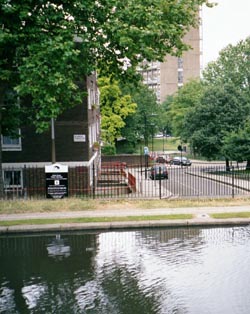 t it was
pretty and jumped.
t it was
pretty and jumped.
Not into the Canal, but across it - via bridge - and down into a sliver of Paddington cut off from the rest of the world by Westway, the overpass/flyover that connects the Marylebone Road (near Madame Tussaud's) with the A40, Western Avenue. Although I've driven up and down the Bruckner Expressway in the Bronx countless times, I'd been unlucky to drive on the Boulevard that runs beneath it only once, and I've never walked there, but I now I think I know what it sounds like. Crossing this barrier - via pedestrian underpass/subway - was a simple matter, but the vehicular traffic flapping over the joints in the road sent up such an awful din that it was hard to believe that our lives weren't in danger. Not unduly rattled, we emerged into Westbourne Grove, and headed toward the Portobello Road and Notting Hill. There was nothing along the road to distract us, although I recall staring at a shopwindow of ornate Victorian chandeliers and wall fixtures, most of them constructed around chubby cherubs, and we talked and talked. The following passage, from a novel whose author I'll get to shortly, captures the miscellaneous, quasi-gypsy air of Westbourne Grove.
The shop, the whole property, was owned by Mr Simon ... and he rented the top two floors to Declan at a ridiculous sum and paid him with equal frugality for managing the shop. He himself was always there in his black skull-cap to greet favored customers, sitting at a Dickensian desk just inside the door, but otherwise he took little part in buying and seeling, although he controlled the flow of cash. The front of the house was arranged under his personal supervision, the pick of the furniture, pictures and artifacts displayed to advantage. It was the back of the ground floor which Declan had made his domain. It was a long conservatory of strengthened glass with each end of two palm-trees, the slender trunks of iron, and the fronds, which trembled as the hand brushed against them, sheets of tin painted a bright green. This touch of Mediterranean sun contrasted with the conservatory's faintly ecclesiastical air. Some of the original lower panes of glass had been replaced by oddly shaped pieces of stained glass from demolished churches: a jigsaw of yellow-haired angels and haloed saints, lugubrious apostles, fragments of a nativity scene or of the last supper, domestic vignettes of hands pouring wine into pitchers or lifting loaves of bread. Placed in happy disorder on a variety of tables, piled up on chairs, were the objects acquired by Declan and it was here that his personal customers rummaged, exclaimed, admired and made their discoveries.
Original Sin, 61 (Time Warner, [1994] 1996)
After a while, the Islamic signage gave way to a nondescript residential
area, and presently we were standing in Portobello Road. 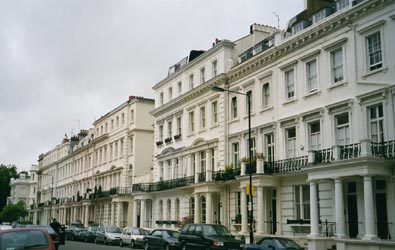 On a weekday, there's not a lot of life in Portobello Road, and most of the
shops are shuttered. Even so, I managed to spend ninety pounds on Spode at an enterprise that
specialized in china and sweaters, each taking up one long wall of the narrow
interior. The Spode was stacked on the floor as if it were the least expensive
crockery at a back-street bazaar, and I have never felt so much like the proverbial
bull. None too soon, I signed a credit card receipt and closed the day's
sole shopping transaction (there would be only two others, the next day, in St
James). We continued up the crooked hillside, and when we got to the top, we
turned right and climbed some more, to the very top of Notting Hill.
On a weekday, there's not a lot of life in Portobello Road, and most of the
shops are shuttered. Even so, I managed to spend ninety pounds on Spode at an enterprise that
specialized in china and sweaters, each taking up one long wall of the narrow
interior. The Spode was stacked on the floor as if it were the least expensive
crockery at a back-street bazaar, and I have never felt so much like the proverbial
bull. None too soon, I signed a credit card receipt and closed the day's
sole shopping transaction (there would be only two others, the next day, in St
James). We continued up the crooked hillside, and when we got to the top, we
turned right and climbed some more, to the very top of Notting Hill.
Julia Roberts' famous smile has assured that everyone knows the name of
Notting Hill. It is a name that has meant different things since its
fourteenth-century debut in the records. I'm not at all sure what it's
boundaries are now. I saw the movie once, and didn't much
like it, so it's no surprise that I didn't recognize any locales on my walk,
which certainly took me through the nicer parts of a neighborhood formerly
notorious for its extremes of wealth and poverty. I saw nothing but evidence of
wealth, with great Belgravian houses along Kensington Park Gardens and a niftily
eclectic little mansion on Ladbroke Grove. There was nothing of
Trollope's dingy Kingsbury Crescent, in Ayala's Angel, to which Lucy
Dormer was forced to move after her father's untimely and improvident death. 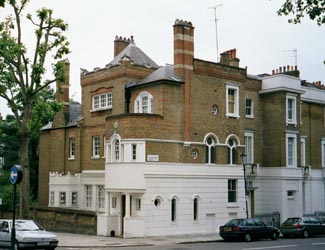
The old piano had not been tuned for the last ten years. The parlour-maid was a cross old woman. Her aunt always sat in the dining-room through the greater part of the day, and of all rooms the dining-room in Kingsbury Crescent was the dingiest. Lucy understood very well to what she was going. Her father and mother were gone. her sister was divided from her. Her life offered for the future nothing to her. But with it all she carried a good courage. There was present to her an idea of great misfortune; but present to her at the same time an idea that she would do her duty.
(Ayala's Angel, Oxford, 1990, 10)
Holland Park Avenue in June is a wide and leafy thoroughfare. We stared for a
few minutes into the window of Lidgate's, an eminent butcher's shop that Judy
had visited on one of her radial outings, and wished that we'd had an excuse to
go in and buy something. Home cooking was not to be part of this trip, however,
and we were happy enough for a quick lunch at a pleasant Italian chain
restaurant. Duly restored, we headed down along Abbotsbury Road and into Holland
Park. I must confess to a Masterpiece-Theater interest in Holland Park. This
once-private estate has given its name not only to the surrounding neighborhood
but also to Phyllis Dorothy, Baroness James of Holland Park - 'queen of crime'
P. D. James, author of Original Sin. Surely in order to guess what it must be like to be Baroness James
of Holland Park, you must have a look at Holland Park, and so we did. We passed some peacocks, and then we
passed what's left of Holland House. Mostly, we talked. We looked for the Rose
Garden, but not hard enough, and soon headed down the hill toward Kensington. At
the front gate of Holland House, now the entry to the Court Theatre, we paused
to listen through the tenting to a rehearsal of the love duet from 'Madame
Butterfly.' When it was over, a slender opera fan standing nearby burst into
bravos before recollecting himself. We passed an animated cricket pitch and out into
Kensington High Street.
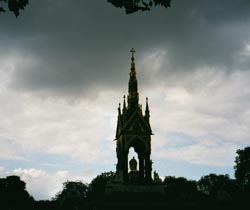
Kensington High Street was just what I'd wanted to see. The street was so busy that the idea of
stopping to take a picture never occurred to me, although I wish it had. I was
reminded, vaguely, of 'downtown' Washington, because the buildings were of about
the same height and density. Unlike Washington's office buildings, most of which
were built long after World War II, Kensignton's more florid edifices date from
the evening of Empire, so the comparison didn't go very far. Kensington was
actually rather more like home, like Yorkville
High Street, although certainly grander-looking. The bustle was tremendous,
and it thickened as we headed east, toward Belgravia and the evening rush.
Somewhere in the vicinity of
Kensington Palace, unseen off to the left, buildings gave way to trees and park
palings on the north
side of the street, while those to our right took on the grandiosity of mansions. Passing the
recently-restored Albert Memorial, we frowned at the barriers that made close
inspection impossible, and the best thing that I can say about the bad
photograph that I took is that it captures the moment's effet d'orage.
Just before the Albert Memorial, we had a look at Virginia Woolf's childhood home in Hyde Park
Gate. The outside looks ordinary enough, but I remembered Hermione Lee's
portrait of its
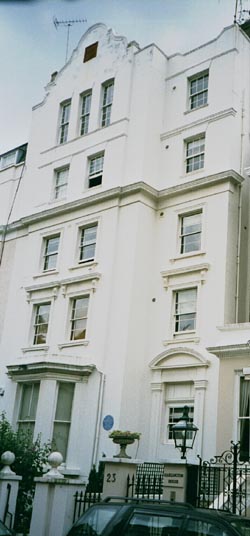 interior.
interior.
The house was dark. This was partly due to the narrowness of the street (looking across at the intimate details of people's lives in the houses opposite was a potent memory, to be used in Mrs. Dalloway), and partly to Julia [Stephen]'s taste. "My mother who had been brought up in the Watts-Venetian-Little Holland house tradition had covered the furniture in red velvet and painted the woodwork black with thin gold lines upon it." The black folding doors of the drawing room were picked out in raspberry red. There were "mounds of plus, Watts' portraits, busts shrined in crimson velvet." There was no electric light. Vanessa, too, remembered the sombre black paint, the dull blue walls absorbent of light, and the evening meals lit by candles when "faces loomed out of the surrounding blackness like Rembrandt portraits." (Hermione Lee, Virginia Woolf, Knopf, 1998 p. 40)
I also remembered a passage that Lee quotes from Night and Day, about the "labor-intensiveness of Victorian domestic life." I could look at the house all I want to, but the world of Virginia Woolf's childhood had passed, mercifully, beyond recapture.
You will note the Blue Plaque to the right of the bay window. Authorized by the late Greater London Council, these commemorate 'distinguished' former residents. How distinguished? Known to the 'well-informed passer-by.' How former? According to The London Encyclopedia, one must have been dead for twenty years, and born over a century ago. The Encyclopedia doesn't add something that Judy told me, which is that in most cases there's only one per customer. The plaque in the photograph does not honor, or even mention, Virginia Woolf. Her marker is somewhere in Bloomsbury - we couldn't find it. This plaque honors her father, the eminent man of letters, Sir Leslie Stephen.
After shuddering at the thought of all that black woodwork, we turned and looked at a house on the other side
of the road, marked with a plaque informing us that here died Sir Winston
Churchill. It's a low-slung, echt Queen Anne affair, looking as though it
preceded the development of the neighborhood.
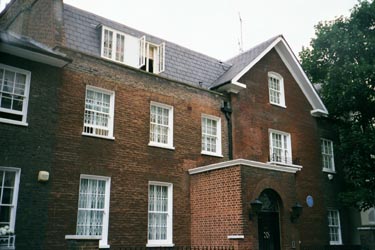 This
part of London, after all, was fairly rural at the time of the American
Revolution. Central now, Kensington was pretty far from the river that
constituted London's principal artery, and its parks are not recent developments
but the remains of an aristocratic exurbia. The West End grew as furiously as
Manhattan's Midtown and Upper East and West Sides between 1860 and World War I.
The difference is New York's abstract grid, laid out upon relative wilderness
and resistant to the tug of traditional routes and natural obstacles.
History has been rationalized out of existence in most of Manhattan. If history
is just a bunch of dates, then that doesn't matter much. But to me history is
all the people who have ever lived, and the conservatism of London's growth has
kept it a city that the bulk of its former inhabitants, distinguished and
otherwise, would recognize chunks of.
This
part of London, after all, was fairly rural at the time of the American
Revolution. Central now, Kensington was pretty far from the river that
constituted London's principal artery, and its parks are not recent developments
but the remains of an aristocratic exurbia. The West End grew as furiously as
Manhattan's Midtown and Upper East and West Sides between 1860 and World War I.
The difference is New York's abstract grid, laid out upon relative wilderness
and resistant to the tug of traditional routes and natural obstacles.
History has been rationalized out of existence in most of Manhattan. If history
is just a bunch of dates, then that doesn't matter much. But to me history is
all the people who have ever lived, and the conservatism of London's growth has
kept it a city that the bulk of its former inhabitants, distinguished and
otherwise, would recognize chunks of.
Walking alongside Kensington Gardens and Hyde Park on our return to Lowndes Square, where our hotel was, Judy and I had no need of maps, but we talked about the remarkable woman who created the A-Z that had shepherded us through the day's new territories. Judy happened to have just read a biography, and she promised to find a copy for me before I left town. Sure enough, it kept me company during the flight home. I only wish I could recommend it, but if ever a book needed to be rewritten, from scratch, it's Sarah Hartley's Mrs P's Journey (Simon & Schuster, 2001). Phyllis Gross Pearsall had a remarkable life by any measure, but Ms Hartley's extremely uneven narrative has no measure at all. A chipper stoic, Pearsall proceeded through life's vicissitudes with the mantra 'On We Go,' but this is not a sound rule for biographers. On the story goes, all right, rarely looking back (and then only sentimentally), and never taking stock, leaving a jumble of dropped leads and unanswered questions. The book left me more puzzled, not less, by its subject. Perhaps, as happened to Elizabeth David a few years after she died, another Pearsall biography will appear presently. I will certainly read it if I can get my hands on it, in hopes of straightening out the many lumps under Hartley's carpet.
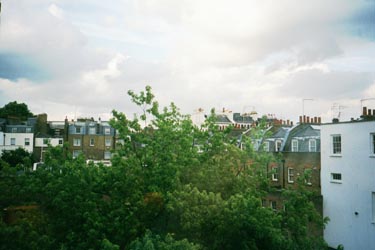
Copyright (c) 2004 Pourover Press